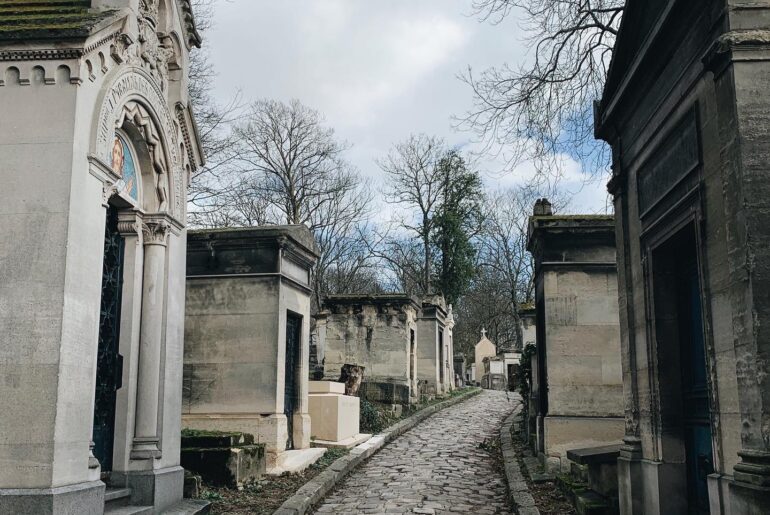Every fall, I ask my friends who would like to hang out with dead people. In other words, a volunteer to join me on my annual Parisian cemetery tour. It’s not uncommon to visit historic graveyards in old cities as a tourist, especially if famous people are buried there. Out of curiosity and respect for historical monuments. But thinking about necropoleis in terms of great hang-out spots feels rather morbid. After all, graveyards aren’t supposed to be enjoyable, much less become a tradition of purely recreational nature. Nevertheless, cemeteries have certain advantages, most desirable in the fall, that cannot be found anywhere else.

They are quiet.
Nothing calms people down as much as death. The phrase “rest in peace” exists for a reason. Even in places where silence is expected, there are people who cannot be quiet. Respected institutions like museums or temples have accepted the characteristic clamor made by visitors. There is always wrestling with other visitors taking up the entire space to take the best photo of something already published on Wikipedia. Cinemas and theaters are powerless against self-appointed critics and rustling wrappers. But cemeteries are free from noise without shushing or hushing anyone. An unwritten rule understood across the world states that death deserves unconditional silence. And as long as it doesn’t apply to mortals, that’s the only way you can get it.

There is something personal about them.
We are born as strangers. That’s why baby showers are the same in their essence. On the other hand, our funeral is usually the last personal thing we receive from our family and friends. Some people buy burial plots and choose the tombstones they want in order to ensure they leave this world as they please. That’s why I find cemeteries to be very personal. Portraits displayed in museums, more often than not, represent a fantasy of the person depicted, but tombstones reflect what was meaningful to the deceased. Often embellished with their best photos and expressive epitaphs, graves usually denote the religion, ethnicity, and sometimes even hobbies of those buried in the ground. Each tells a story of individuals who lived in Paris before us and, therefore, of the entire city. This prompts reflection of a completely different kind than merely aesthetic.


They’re free of charge.
Adulthood has many perks, but it also comes at a price. Most times, it means literally paying money. If you have a penchant for cultural activities, you’ve probably noticed that they are costly. By now, you’ve also already realized that it’s never just going to a museum or cinema, and the price of tickets gets doubled by the cost of a restaurant where you must discuss everything you saw plus recent life updates. That being said, as dumb as it may sound, it’s noteworthy that cemeteries are free of charge. Considering the artistic value of tombstones, it is safe to compare some necropoleis, such as Père-Lachaise, to open-air museums with no entry fees. They may not have bathrooms, which can be a bummer, but just like adulthood, good things tend to imply certain sacrifices.






2 Comments
L’autre jour, je rentrais d’un rdv et l’attroupement d’un groupe de touristes m’a fait réaliser que j’étais devant le célèbre cimetière de Montparnasse !
D’habitude, les cimetières, ce n’est pas mon truc (la faute à mon métier qui m’a souvent amené…à l’Institut médico-légal et aux différents cimetières parisiens et de Pantin. Mais, là, je ne sais pas…Je crois que je me suis dit : ” Attends, c’est con…Il y a un groupe de touristes qui sont enthousaistes à l’idée d’aller voir un endroit, ils viennent de loin et toi, t’es, parisienne – certes depuis peu -, tu es locale et tu n’as même jamais vu les lieux ?! Il faut y rémédier de suite !”
Je dois dire que j’ai passé un… joli moment. Certaines tombes sont de vraies oeuvres d’art; et d’autres donnent un aperçu de la personnalité qu’avait la personne de son vivant; d’autres trahissent la douleur des parents qui doivent vivre après la perte tragique d’un enfant ( que ce soit un bébé ou une jeune adulte); d’autres étaient joliment ornées de statues gigantesques, cadeau ultime d’amis (et la tut te dis : “L’amitié, c’est vraiment la famille de coeur !”.
J’ai vu la tombe de Maryse Bastié (le nombre de fois où quand j’ai entendu “Statron Maryse Bastié” dans le tram, lorsque j’habitais hors de Paris ! Alors, voir sa tombe des anées plus tard, c’était comme un clin do’eil du destin.
Mais, ce qui m’a paru le plus fou, c’est que, sans faire exprès, je me suis arrêtée à une tombe d’un jeune homme mort durant la première guerre mondiale, et hasard incroyable du calendrier, cela faisait exactement 110 ans, jour pour jour (passé le moment de recueillement ” Oh là là, t’avais même pas 22 ans, je suis vraiment désolée de c e qui t’es arrivé’, je n’ai pas pu m’empêcher de dire devant sa tombe : ” Attends, toi, me suis pas jusqu’à chez moi ! Je veux pas de fantômes ! “)
Le fait peut-être le plus poignant est que les tombes sont des monuments dédiés à des personnes autrefois vivantes et, sous cette forme, elles sont souvent plus sincères que des œuvres d’art.